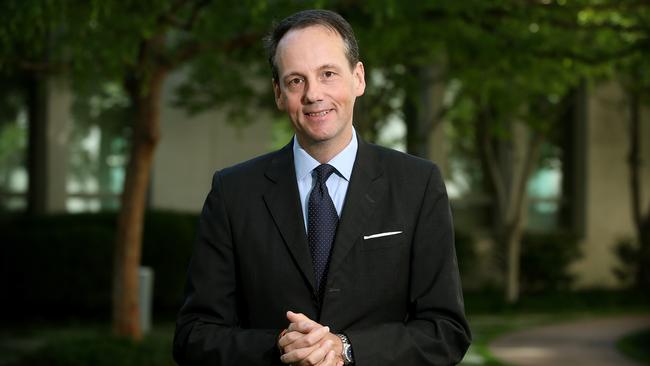ASIC bid to embed agents in big banks to clean up industry
ASIC chairman James Shipton is seeking funding for a plan to embed supervisors in the big banks to help them rebuild trust.

The nation’s scandal-plagued banks are bracing for a new, more intrusive style of regulation, with Australian Securities & Investments Commission chairman James Shipton ​seeking extra funding for a plan to embed specialist supervisors in the major banks to help drive cultural change and rebuild trust.
Mr Shipton, who was previously in charge of the supervisory arm of the Securities and Futures Commission of Hong Kong, has presented the plan to Canberra as an effective way of tackling the misconduct and poor behaviour featured in the financial services royal commission.
Momentum for serious reform has also gathered since three of the four big banks paid a collective $125 million to settle cases of interest rate rigging brought by ASIC.
The fourth bank, Westpac, contested similar allegations, but was found by the Federal Court last week to have engaged in unconscionable conduct.
With trust in the sector at a worryingly low ebb, Mr Shipton has started taking his case for a regulatory circuit-breaker to industry leaders, arguing that enhanced supervision, sometimes including temporarily embedded ASIC specialists, would help ensure that past mistakes are not repeated. In some cases, he has referred to a supportive 2011 discussion paper issued by the Institute of International Finance, a global association for the financial services industry.
Former ANZ Bank chief executive Mike Smith was on the board of the IIF at the time, and the special committee responsible for the paper included Rodney Maddock, the Commonwealth Bank’s head of strategy at the time.
The paper, Achieving Effective Supervision: An Industry Perspective, accepts that regulation alone can’t create a safer financial system — it can only do so in conjunction with a strengthened global supervisory system and improved industry practices.
It also advocates engagement with the regulator and its supervisors on a “no surprises” basis instead of the legalistic approach prevalent in Australia of running a microscope over breaches to determine if they are sufficiently material to report.
Advocates of a “no surprises” framework have said it would encourage more effective engagement, in contrast with AMP’s admission in the royal commission last month that it had misled ASIC in the fees-for-no-service scandal.
Canberra sources have told The Australian that discussions between Treasury and Mr Shipton about extra funding have been “productive”.
More information on ASIC’s budget could emerge on Wednesday, when Mr Shipton appears before estimates.
An ASIC spokesman declined to comment on the watchdog’s budget, or the chairman’s plans for more intense supervision of the financial services sector.
Instead, he referred to a speech by Mr Shipton at the Australian Council of Superannuation Investors annual conference, in which an oblique reference was made to a “new supervisory focus” on Australia’s largest financial institutions and superannuation funds. The ASIC boss also said the nation’s corporations, and finance sector in particular, were suffering from a “trust deficit”.
“And this current predicament is of the sector’s own making,” Mr Shipton said.
“And because it is largely of its own making, the sector must be held to account and must take responsibility for its repair.”
The dramatic push by ASIC for a supervisory solution has precedents around the world, not only in Hong Kong.
The US Federal Reserve takes a supervisory approach to its prudential mandate, often embedding its officers in the nation’s large institutions.
An extreme version was implemented in the US at the peak of the financial crisis, with dozens of supervisors permanently embedded in the country’s large banks and investment banks.
The trigger for Goldman Sachs and Morgan Stanley was their 2008 conversion into traditional bank holding companies, which meant they came under the supervision of the US Federal Reserve.
The supervisors marched in as the former investment banks became subject to more intense supervision and new capital requirements.
Mr Shipton, however, is understood to have been pitching a more measured approach.
Along with on-site supervision, where ASIC staff would sometimes be embedded, the watchdog would guard against “regulatory capture” by working off-site, as well as conducting surveillance, or data collection and analysis.
The approach would be carefully calibrated to suit the circumstances, and be scaled up or back as the situation required.
One of the strong arguments in favour of enhanced supervision is that heavy consolidation in parts of the Australian financial services industry, particularly banking, makes it ideally suited to the intervention.
With 70 to 80 per cent of the banking market in the hands of four institutions, valuable insights can be gained from data collection and analytics, and the number of in-house specialists required to do an effective job would be relatively low.
While they have different mandates, ASIC would also be expected to work co-operatively with the Australian Prudential Regulatory Authority.
APRA’s brief is to ensure the safety and soundness of the financial system, whereas ASIC is concerned with market integrity and good conduct. Both have a strong interest in culture, because misconduct and poor behaviour can affect the soundness of an institution, which is APRA’s patch, as well as the interests of the consumer, which is ASIC’s territory.




To join the conversation, please log in. Don't have an account? Register
Join the conversation, you are commenting as Logout